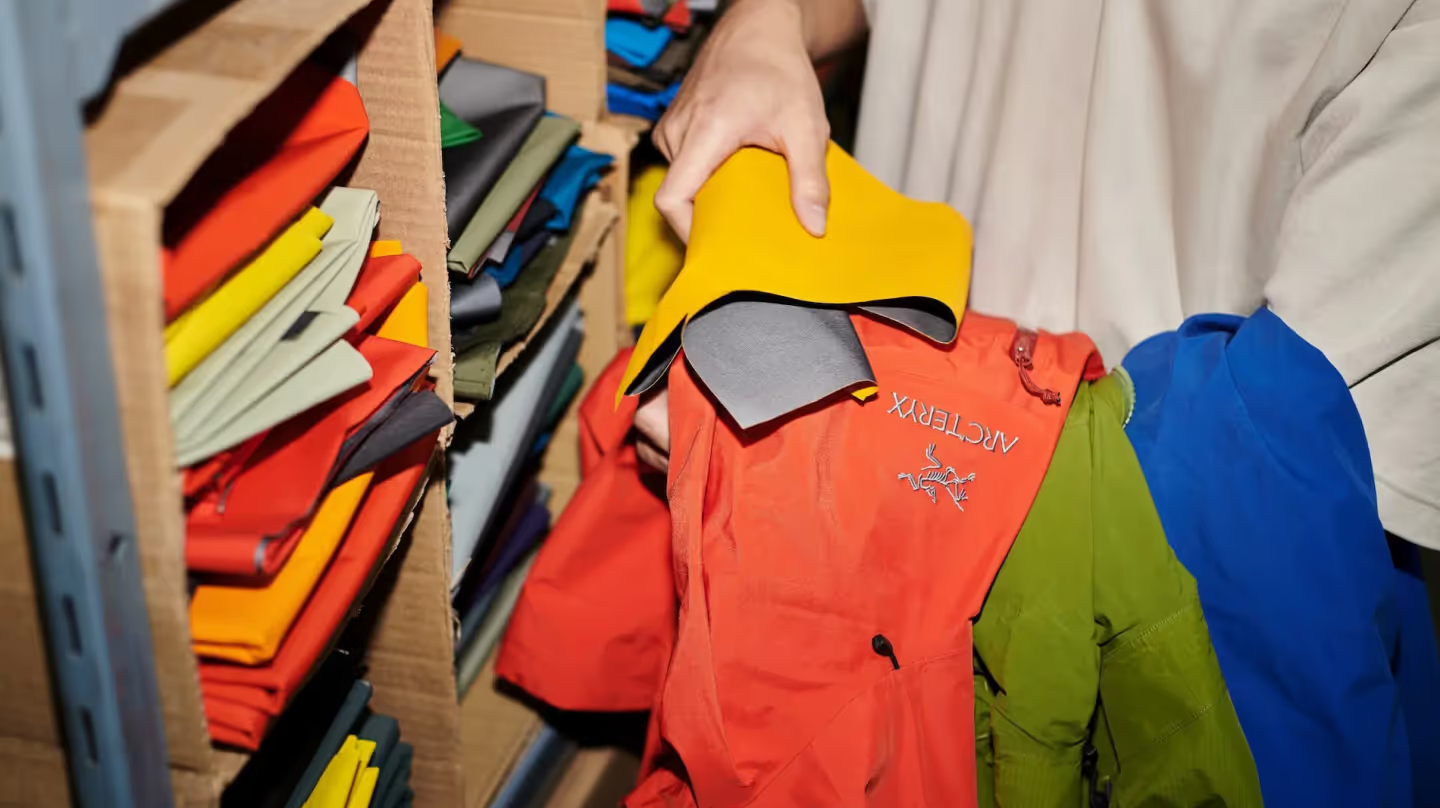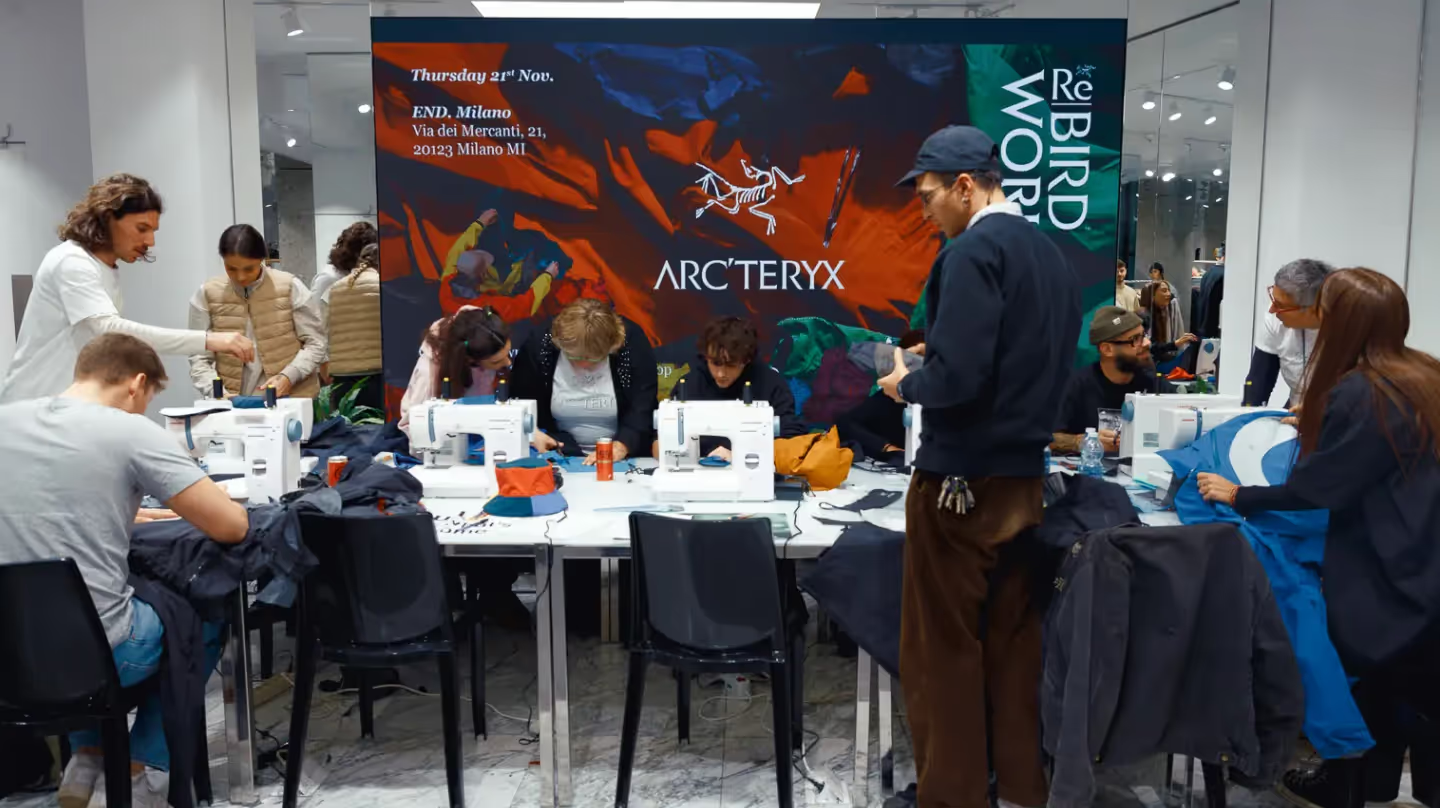Summary

From High-Performance to High-Impact: Why Circularity Fits Arc’teryx
Arc’teryx has built its reputation on gear that performs in the most demanding environments. Whether scaling alpine routes or navigating wet Pacific forests, customers trust the brand for precision, protection, and durability. But performance alone is no longer enough. As environmental pressures rise and consumer expectations shift, long-lasting gear must also become part of a long-lasting business model.
That’s where circularity comes in.
With the launch of ReBird in 2021, Arc’teryx signaled a new era—where product longevity is not just a feature, but a foundation for transformation. Circularity isn’t an add-on. It’s a way to deepen customer loyalty, reduce waste, and tap into new value streams across the entire lifecycle of a product.
The strategy goes beyond resale. ReBird weaves repair, upcycling, and refurbishment into the brand’s DNA. Customers get extended product life and support. The company gets operational resilience, margin recovery, and direct alignment with growing environmental expectations.
And the stakes are high. Arc’teryx has committed to reduce absolute Scope 1 and 2 emissions by 90% and Scope 3 emissions by 42% by 2030. These science-based targets can’t be met with offsets or campaigns alone. They require systemic change. By shifting from a “take-make-waste” model to a closed-loop approach, Arc’teryx is turning performance gear into a platform for climate action.
ReBird Explained: Repair, Resale, and Upcycling Under One Roof
ReBird is not just a program — it’s a platform. At the heart of Arc’teryx’s circular economy efforts, it brings together three distinct but interconnected areas: ReCare, ReGear, and ReCut. Each plays a different role in keeping high-performance gear in use, while offering customers real value, convenience, and creativity.

ReCare is all about product longevity. It gives customers access to both quick in-store fixes and more complex off-site repairs:
- Free assessments and basic services like zipper fixes, cord replacements, and patching
- Technical wash and re-waterproofing for GORE-TEX products
- Fast turnaround times at select stores, with some fixes done on the spot
ReGear is the resale and trade-in component. Customers can return used Arc’teryx gear and receive 20% of the original retail price as store credit. These items are then refurbished to near-new condition and made available at lower prices through the ReBird resale platform. This benefits customers who want to save while supporting circularity — and it helps Arc’teryx recover value from existing products.
ReCut is the most creative pillar. Here, end-of-life gear and leftover materials are transformed into limited-edition pieces, such as pouches, totes, or jackets. These upcycled items bring uniqueness and storytelling into the mix, and they show what’s possible when design and sustainability meet.
Together, these three components make circularity more than a promise — they make it a real, visible part of the customer experience. Whether shopping for a deal, extending the life of a jacket, or discovering something one-of-a-kind, customers interact with ReBird both online and in-store. From flagship stores in New York and London to pop-ups and repair stations on ski fields, ReBird is seamlessly integrated into the Arc’teryx ecosystem.
The Customer Journey: Trade-In, Repair, and Circular Design
Circularity at Arc’teryx doesn’t start in a factory or a climate report — it starts in the hands of the customer. Through ReBird, Arc’teryx has built a circular experience that is intuitive, accessible, and genuinely useful. Whether returning old gear, walking in for a quick fix, or getting a technical garment serviced, customers are invited to participate directly in the brand’s sustainability mission.
Trade-In: Value for the Past, Credit for the Future
Customers can trade in used Arc’teryx products and receive 20% of the original retail price as store credit. The value is fixed and transparent — for example:
- Atom Hoody Women’s: $60 store credit
- Cerium Hoody Women’s: $80 store credit
- Beta AR Jacket Men’s: $120 store credit
These trade-ins are accepted at participating stores and events, and the program has seen rapid growth. Pop-ups alone recorded a 371% increase in trade-ins year-over-year, proving that customers are eager to return quality gear for meaningful rewards.
Repair: From Mountainside to Service Center
For those who want to keep their gear in use even longer, ReCare offers a full range of repair services. The experience is designed to be fast and frictionless:
- Walk-in repairs for zipper pulls, buckles, or small tears
- In-store product assessment, including leak testing for GORE-TEX
- Technical washing and re-waterproofing to restore high-performance fabrics
- Complex repairs managed at regional centers or the Arc’One facility in BC
Turnaround can be impressively quick — many customers report 5-minute repairs for minor issues. Others drop off gear before a ski trip and pick it up fully serviced by the end of the day. The convenience encourages repeat use and builds loyalty around care, not just consumption.
Design Feedback: Closing the Loop
Service centers don’t just fix gear. They also feed insights back into the design process. By tracking common repair needs — like seam failures or zipper issues — the Arc’teryx product team can make durability improvements in future models. This loop turns customer care into product innovation, strengthening both sustainability and performance over time.
With ReBird, circularity becomes more than a philosophy. It becomes a practical, everyday journey that meets customers where they are — and brings them back.

Scaling ReBird: From Canada to China
ReBird was never meant to be a small-scale experiment. From the start, Arc’teryx designed it to be a global platform — embedded into the brand’s retail presence and aligned with international climate goals. As of 2024, that vision is well underway, with ReBird now operating across continents and in some of the world’s most iconic cities.
A Growing Global Footprint
- 25+ ReBird Service Centers offer on-the-spot care and access to circular services.
- More than 80 Arc’teryx stores globally feature ReBird integration, from trade-in to repair support.
- Regional repair centers and the Arc’One facility in British Columbia handle complex refurbishments at scale.
This infrastructure allows Arc’teryx to deliver consistent service and extend product life — whether you’re in a flagship store or dropping off a jacket at a ski field pop-up.
Key Locations Leading the Way
The ReBird presence is especially strong in cities where performance and sustainability intersect:
- New York City: Home to the first ReBird Service Center, launched in late 2021.
- Toronto Eaton Centre: A major Canadian hub, launched in mid-2022.
- London (Covent Garden): One of the program’s European flagships.
- Tokyo and Beijing: Extending circular services into key Asia-Pacific markets.
- Jilin City, China: A seasonal location located directly on the ski slopes — proof that service can go wherever customers are.
What’s Next: Scaling Further in 2025
Arc’teryx has announced plans to open 25 new stores globally in 2025, many of which will feature ReBird Service Centers from day one. Alongside this retail growth, the brand is:
- Expanding the range of repair capabilities to include advanced garment reconstruction
- Scaling upcycling programs through ReCut, based on the growing demand for one-of-a-kind gear
- Investing in education and training to ensure consistent quality across regions
With ReBird, Arc’teryx isn’t just adding sustainability to its stores — it’s building a global circular network. A jacket traded in Vancouver might be refurbished in BC and resold in New York. A torn sleeve in Tokyo might inspire a design tweak back at headquarters. It’s a circular system with real-world impact, powered by local action and global coordination.
Business Meets Impact: Revenue Growth Through Circularity
ReBird doesn’t just tick a sustainability box — it delivers real financial results. By turning returned gear into refurbished inventory and repairs into brand touchpoints, Arc’teryx has built a circular model that drives growth, not cost.
The numbers speak clearly:
- +127% growth in resale program sales
- +25% increase in repair engagement across the network
- 20,216 repairs completed globally in 2023
These outcomes show that ReBird is more than a feel-good initiative. It’s a system that increases product margins, reduces returns, and boosts customer lifetime value — all while minimizing environmental footprint.
Younger customers are taking notice. ReBird has proven especially effective in attracting sustainability-minded Gen Z and Millennial buyers who value quality, purpose, and transparency. The program also builds loyalty over time: customers who engage with repair and trade-in services are more likely to return, recommend, and repurchase.
By giving people more ways to interact with the brand — beyond the first sale — ReBird creates a continuous value loop. It’s not just circular in terms of materials. It’s circular in terms of customer engagement.

Emissions Down, Gear in Use: Environmental Wins
Arc’teryx didn’t launch ReBird just to recover gear. It launched it to cut emissions, reduce waste, and support its science-based climate goals. And the environmental returns are becoming measurable.
Impact in 2023 alone:
- 7,443 kg of waste diverted from landfill — the equivalent of 66 dumpsters
- 74,000 kg of CO₂ emissions saved through repairs and reuse
- 20,216 repairs performed, extending product life instead of starting from scratch
These figures aren’t just by-products of the program — they’re the outcome of design choices, operational investment, and customer participation.
ReBird directly contributes to Arc’teryx’s ambitious climate targets:
- 90% reduction in Scope 1 and 2 emissions by 2030
- 42% reduction in Scope 3 emissions by 2030
- Net-zero emissions by 2050
While most companies still focus on carbon offsets or end-of-life disposal, Arc’teryx is investing in circular operations that avoid emissions in the first place. That includes repairs instead of replacements, resale instead of new production, and upcycling instead of landfill.
Regionally, repair growth also tells the story of scale:
- +128% in the US
- +63% in Canada
- +14% in China
- +2% in EMEA
Each fix extends the life of premium gear — and each region contributes to a global system where performance and responsibility go hand in hand.
Leading by Example: What Other Brands Can Learn
Arc’teryx shows that circularity doesn’t have to sit in a sustainability silo. When embedded into design, retail, and operations, it becomes a powerful driver of value — for business, customers, and the planet.
Other brands can take several lessons from ReBird:
- Design for repair: Service centers feed insights directly into product development, helping future gear last longer and perform better.
- Make circularity visible: With in-store repairs, resale racks, and upcycled drops, customers see and experience sustainability — not just read about it in a report.
- Connect global strategy to local action: From BC to Beijing, ReBird builds loyalty through care, not just product.
- Partner for scale: By joining initiatives like the Ellen MacArthur Foundation’s Fashion ReModel, Arc’teryx aligns with industry leaders to move faster and smarter.
Most importantly, Arc’teryx proves that sustainability doesn’t have to come at the cost of performance or profitability. Done right, it enhances both. Circularity isn’t a compromise — it’s a competitive edge.
Curious how ready your own company is for the circular shift?
👉 Take our Circularity Check and find out where to start.
FAQs
How does the Arc’teryx ReBird trade-in program work and how much store credit do you get?
Through ReBird’s ReGear program, you can trade in eligible Arc’teryx gear at select stores and receive 20% of the original retail price back as store credit. Trade-in values are fixed and transparent — for example, you can get $60 for an Atom Hoody Women’s, $80 for a Cerium Hoody Women’s, and $120 for a Beta AR Jacket Men’s. Items must meet condition and category criteria, and credit can be used toward new purchases online or in-store.
Where can I get my Arc’teryx jacket repaired through the ReBird program?
Repairs are available at 25+ ReBird Service Centers located inside Arc’teryx stores across North America. In-store teams can provide quick fixes like zipper pulls or patching, while more complex repairs are sent to regional centers or the Arc’One facility in British Columbia. Customers can also access assessment and technical wash services, including waterproofing for GORE-TEX gear.
What kind of products can I buy through Arc’teryx ReGear resale and are they refurbished?
Arc’teryx ReGear offers professionally refurbished gear that has been traded in, cleaned, and restored to near-new condition. These include jackets, midlayers, and packs at discounted prices. All items go through quality control to ensure performance and longevity. The resale offering is available online and in select Arc’teryx stores.
What is the difference between ReBird ReCare, ReGear, and ReCut at Arc’teryx?
- ReCare focuses on repairs and maintenance — from walk-in zipper fixes to technical washes and waterproofing.
- ReGear handles resale and trade-in, allowing customers to return used gear for credit and shop refurbished products.
- ReCut turns end-of-life gear and materials into upcycled items like totes, pouches, and limited-edition jackets.
- Together, these three pillars cover the full circular journey: care, reuse, and reinvention.
How long does an Arc’teryx in-store repair take and what services are included?
Simple in-store repairs — like zipper pulls, cord locks, and patching — can often be done in 5–10 minutes. Technical services such as GORE-TEX leak testing, waterproofing, or major fixes may take longer and are handled off-site. Customers can typically drop off gear before an activity and pick it up the same day or next.
Is Arc’teryx ReBird available in Europe or Asia and where are the service centers?
Yes. ReBird has an international presence with service centers in:
- London (Covent Garden)
- Tokyo and Beijing
- Toronto, Vancouver, and New York
- Jilin City (China ski resort location)
- More locations are planned as part of the 2025 retail expansion. Each location offers a mix of repair, trade-in, and upcycling services, depending on setup.
How does the Arc’teryx ReBird program contribute to climate and sustainability goals?
ReBird plays a key role in helping Arc’teryx reach its science-based climate targets, including:
- 90% reduction in Scope 1 and 2 emissions by 2030
- 42% reduction in Scope 3 emissions by 2030
- Net-zero emissions by 2050
- In 2023 alone, the program diverted 7,443 kg of waste and saved 74,000 kg of CO₂ emissions by repairing and reselling gear instead of producing new items. Every repair or trade-in helps reduce environmental impact and extend product life.




